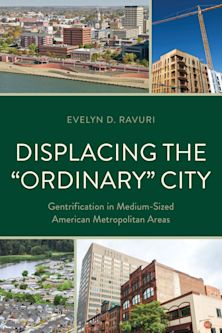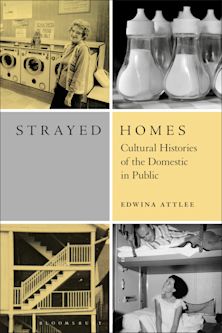- Home
- ACADEMIC
- Geography
- Human Geography
- Gendering the City
Gendering the City
Women, Boundaries, and Visions of Urban Life
Kristine B. Miranne (Anthology Editor) , Alma H. Young (Anthology Editor) , Caroline Andrew (Contributor) , Marilyn Bruin (Contributor) , Christine C. Cook (Contributor) , Sue Crull (Contributor) , Judith A. Garber (Contributor) , Melissa R. Gilbert (Contributor) , Helen Harrison (Contributor) , Sue A. Hendler (Contributor) , Beth Moore Milroy (Contributor) , Evelyn Peters (Contributor) , Marsha Ritzdorf (Contributor) , Daphne Spain (Contributor) , Jennifer E. Subban (Contributor)
Gendering the City
Women, Boundaries, and Visions of Urban Life
Kristine B. Miranne (Anthology Editor) , Alma H. Young (Anthology Editor) , Caroline Andrew (Contributor) , Marilyn Bruin (Contributor) , Christine C. Cook (Contributor) , Sue Crull (Contributor) , Judith A. Garber (Contributor) , Melissa R. Gilbert (Contributor) , Helen Harrison (Contributor) , Sue A. Hendler (Contributor) , Beth Moore Milroy (Contributor) , Evelyn Peters (Contributor) , Marsha Ritzdorf (Contributor) , Daphne Spain (Contributor) , Jennifer E. Subban (Contributor)
This product is usually dispatched within 3 days
- Delivery and returns info
-
Free CA delivery on orders $40 or over
You must sign in to add this item to your wishlist. Please sign in or create an account
Description
This volume challenges the imagery of cities by looking through a gendered lens at how women utilize urban space. Focusing on the conceptual and methodological manner of boundaries, the book reminds us that women are members of multiple and diverse groups and as such, they can be active, creative, and powerful agents. Multidisciplinary essays, contributed by urbanists, geographers, political scientists, and historians, explore the ways in which women confront, break down, resist, and form new boundaries and interconnections, both visible and invisible. Arguing for a change in the traditional agenda of cities, the authors investigate how aspects of urban life and space would look considerably different if the alternatives and options presented by women and other marginalized groups were taken into account. They urge us toward a better understanding of how diverse social groups interact, how urban space can enhance such interaction, and what role formal and informal laws, by-laws, policies, and other planning measures should play.
Table of Contents
Part 2 Part I: Visible or Invisible? Gendered Urban Boundaries
Chapter 3 1 Not Named or Identified: Politics and the Search for Anonymity in the City
Chapter 4 2 The Two Major Living Realities: Urban Services Needs of First Nations Women in Canadian Cities
Part 5 Part II: Intersections of Gendered Boundaries: Race, Class, and Ethnicity
Chapter 6 3 Identity, Difference, and the Geographies of Working Poor Women's Survival Strategies
Chapter 7 4 Boundaries Cracked: Gendering Literacy, Empowering Women, and Building Community
Chapter 8 5 Black Women as City Builders
Chapter 9 6 Women Embounded: Intersections of Public Housing Policy and Welfare Reform
Part 10 Part III: Challenging Planned Boundaries
Chapter 11 7 Theorizing Canadian Planning History: Women's Gender and Feminist Perspectives
Chapter 12 8 Resisting Boundaries? Using Safety Audits for Women
Chapter 13 9 Sex, Lies, and Urban Life: How Municipal Planning Marginalizes African-American Women and Their Families
Chapter 14 10 Manipulating Constraints: Women's Housing and the Metropolitan Context
Chapter 15 Epilogue: Cracks, Light, Energy
Product details
| Published | Jan 19 2000 |
|---|---|
| Format | Paperback |
| Edition | 1st |
| Extent | 240 |
| ISBN | 9780847694518 |
| Imprint | Rowman & Littlefield Publishers |
| Dimensions | 227 x 146 mm |
| Publisher | Bloomsbury Publishing |
About the contributors
Reviews
-
Gendering the City provides a significant contribution to urban studies, balancing critiques of domination with analyses of how groups and individuals have actively carved out spaces that resist and reconfigure dominant gender regimes. The collection draws on a wide range of empirical work, conducted in both Canada and the United States, to explore the diversity of women's experiences. It is both grounded and provocative.
Ann Forsyth, Harvard University Graduate School of Design
-
Gendering the City represents a contemporary collection of essays that examine a diversity of women's experiences while successfully adhering to the main theme of visible and invisible boundaries. The political positioning of the book both deconstructs the silencing of women and provides refreshingly innovative ways of rethinking spatial knowledges of the urban environment.
American Journal of Sociology
-
In Gendering the City, Kristine Miranne and Alma Young have brought together an interesting collection of essays about Canadian and U.S. cities. Although the topic, approach, and tone of the chapters of this volume are predictably varied, the editors have done an admirable job in focusing the material on the broad issue of boundaries. The book itself is a slim, attractive volume. The bibliographies and notes are at the end of each chapter and there is a thorough index to the entire volume. The editors have done their job well. The book is valuable, particularly in its attention to race, ethnicity and class in women's lives.
Gender, Place and Culture: A Journal of Feminist Geography
-
This volume would make an excellent resource for readings in urban studies courses. The wide range of topics covered makes the work useful in a range of courses, or for a variety of topics within a survey course. Gendering the City makes a strong contribution in this area.
Urban Studies
-
An important and useful collection with an impressive mix of senior and junior scholars. The gendered-boundaries concept puts the arguments in fresh perspective, and the material on African-American women and indigenous women is a welcome addition.
Susan E. Clarke, University of Colorado


































